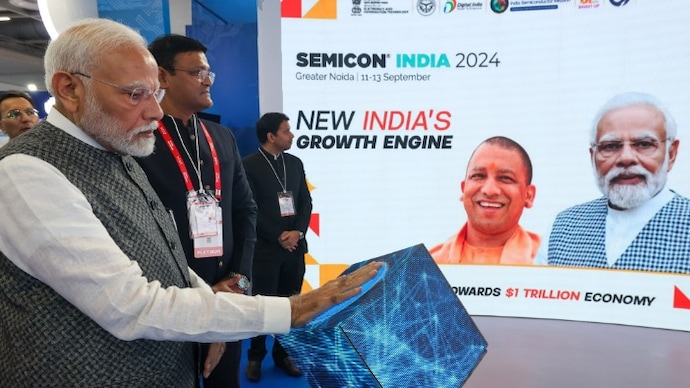The Impact of Semiconductor Production on India:
India is witnessing a semiconductor revolution that is set to reshape its economy. With the India Semiconductor Mission (ISM) and massive government investments, India is positioning itself as a global leader in semiconductor production. As global supply chains face challenges, especially due to US-China trade tensions, India has seized the opportunity to bolster its semiconductor production capabilities.
India’s ₹1.5 lakh crore investment in semiconductor manufacturing reflects our ambition to become a global leader. Our goal is to see an Indian-made chip in every device worldwide.
Prime Minister Narendra Modi at SEMICON India 2024

Global Context and India’s Opportunity
The global semiconductor market is rapidly evolving, with China being one of the largest players, boasting a market size of around $180 billion. However, India’s semiconductor market, valued at $38 billion, is now rapidly catching up. The country’s strategic investments, combined with global geopolitical shifts, provide India with a golden opportunity to become a key player in the global semiconductor industry
India’s Semiconductor Dependency and Market Impact
India has historically relied heavily on semiconductor imports from countries like China, Taiwan, and South Korea. This dependency exposed India to global supply chain disruptions, especially during the global chip shortage in 2020, affecting industries from automotive to electronics, driving up costs and causing production delays
Strategic Moves by India in Semiconductor Production
To combat these challenges, India has taken significant steps. Notable is the India-Singapore Semiconductor Ecosystem Partnership, signed by Prime Ministers Narendra Modi and Lawrence Wong. This partnership strengthens India’s semiconductor industry, which is further boosted by a $10 billion investment from Tower Semiconductor and Adani Group, establishing a state-of-the-art semiconductor fab in Maharashtra
Investment Opportunities and Government Initiatives
The Indian government has committed ₹76,000 crore under the India Semiconductor Mission (ISM) to establish five major semiconductor projects. These units will receive both central and state government subsidies, attracting domestic and international investors.
The Prime Minister’s Office recently approved the construction of three new semiconductor units as part of its expanded mission. This is a pivotal move to create a self-sustaining semiconductor ecosystem, ensuring that India becomes a leading manufacturer.
Environmental Impact and Sustainability Challenges
Despite the economic growth potential, semiconductor manufacturing is resource-intensive. It requires large amounts of water and produces significant chemical waste. Sustainability challenges include ensuring that the environmental impact is minimized. India’s semiconductor plants need to adopt sustainable production methods to mitigate these challenges.
Economic Impact and Job Creation
The growth of India’s semiconductor sector is expected to create thousands of high-skilled jobs. The government’s aim is to train over 85,000 skilled professionals by 2030. This expansion will contribute significantly to India’s GDP, helping industries like electronics, automotive, and telecom.
Why Did India Enter the Semiconductor Sector Late?
India’s late entry into the semiconductor market is attributed to factors such as high capital investment costs, a lack of infrastructure, and the dominance of imports. However, recent initiatives and investments are accelerating India’s journey toward becoming a global player.
Challenges India Faces in Semiconductor Production
- High Capital Investment: Building semiconductor fabs requires billions in investments.
- Lack of Technological Expertise: India must develop local expertise similar to that of global giants like TSMC and Samsung.
- Supply Chain Dependencies: India still relies heavily on imports for critical equipment and raw materials.
- Geopolitical Risks: Tensions like the US-China trade war pose risks to global supply chains, affecting India
Conclusion
India’s semiconductor revolution presents enormous potential, but the journey will not be without challenges. By addressing capital investment, building technological expertise, and creating a sustainable production ecosystem, India is on the path to becoming a global leader in semiconductor manufacturing.
Read now – Ford’s Return to India: A Bold Comeback after 2 years
FAQs:
1. Why is semiconductor production important for India?
Semiconductor production is essential for India’s growth as it powers industries like electronics and automotive, reducing dependency on imports and enhancing supply chain resilience.
2. What initiatives are driving India’s semiconductor industry?
India’s India Semiconductor Mission (ISM), supported by ₹76,000 crore, is a major initiative aimed at building the country’s semiconductor production infrastructure.
3. How will the global semiconductor shortage impact India?
Global shortages have led to production delays and increased costs for industries in India, especially in sectors like automotive and consumer electronics. Expanding domestic production will help India mitigate these issues.








